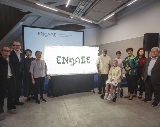At an NUS Giving Experience session, Prof Roger Foo shared how molecular tools and gene therapy can combat heart diseases.
Cardiovascular disease is a major cause of concern globally. This leading killer claims about 17.9 million lives every year, according to the World Health Organisation. In Singapore, heart disease or stroke caused one-third of deaths in 2020. Even if patients survive debilitating heart attacks, they are not out of the woods — they have a high likelihood of heart failure.
The heart of the issue is the organ’s inability to self-repair, said Professor Roger Foo of the NUS Yong Loo Lin School of Medicine, Cardiovascular Research Institute. He was speaking at an NUS Giving Experience series session held on 23 February 2022, where he delved into ‘Molecular Tools to Heal the Heart’, also the title of the talk.
Director of NUHS Cardiovascular Disease Translational Research Programme, Professor Roger Foo Sik Yin passionately shares lifesaving research findings with guests.
“When you get a heart attack, you stop smoking, change your diet, your lifestyle, and so on. But unfortunately, despite all those changes, heart attacks leave a scar on the heart, and heart failure, some years later, is almost inevitable. The reason it's inevitable is that the heart is not a self-healing organ,” he explained.
Studies have shown that some selected animals are able to repair their hearts cells, Prof Foo shared. Neonatal mice, under a week old, are able to mend the damage caused by a heart attack. If part of a zebrafish’s heart is sliced off, its heart regenerates and regains its full function.
“Zebrafishes are able to regenerate their hearts and the regeneration comes from pre-existing heart cells. If our hearts were like the hearts of zebrafish, then we won't have a problem with heart failure,” Prof Foo shared.
How can human hearts self-heal like zebrafishes and newborn mice? It turns out that the answer could lie in our genes.
Together with his team at the NUS Yong Loo Lin School of Medicine and National University Hospital, Prof Foo constructed the world’s first map of the heart’s genes and annotated “switches” that control how the genes behave.
With the illuminating map in hand, clinician scientists are searching for the elusive genetic “switches” that could turn off heart failure forever.
Currently, gene therapy is shedding light in this area of research. Results from a cutting-edge experiment showed that a single injection administered to monkeys disabled a single gene and is able to reduce their cholesterol significantly, once and for all. Earmarked as a game-changer for medicine, the cholesterol-lowering jab promises to decrease the risk of strokes and heart diseases.
Closing off his presentation with the inspirational landmark study, Prof Foo said: “If you find the exact set of switches, you can actually change gene programmes, flip the switch, and you can get there. I'm ending with this example that shows that our aspiration is actually possible.”
For further information on the NUS Giving Experience Series, contact the Events team at dvoevents@nus.edu.sg.






